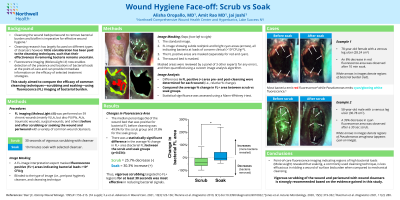Clinical Research
(DLS-035) Wound Hygiene Face-off: Scrub vs Soak
Friday, April 28, 2023
7:15 PM - 8:30 PM East Coast USA Time

Amit Rao, M.D. – Project Manager, Surgery, Northwell Health Comprehensive Wound Healing & Hyperbaric Center; Jai Joshi, B.S. – Visiting Scholar, Surgery, Northwell Health Comprehensive Wound Healing & Hyperbaric Center
Introduction: Cleansing to remove bacterial burden and biofilm is imperative for effective wound hygiene. Although research has focused on different types of dressings little consideration has been paid to the cleansing techniques, such that their effectiveness in removing bacteria remains uncertain. Point-of-care fluorescence (FL) imaging to evaluate bacterial burden can provide immediate information on the efficacy of selected treatment strategies. This study aimed to evaluate the efficacy of common cleansing techniques using FL-imaging of bacterial burden.
Methods: FL-imaging was performed on 14 chronic venous lower extremity wounds before and after a 10-min soak or thirty-second scrub with a variety of common wound cleansers. The wound bed and fluorescence positive (FL+) areas of the images were masked by a FL-image interpretation expert (blinded to the type of image-pre/post, cleanser, and cleansing technique used), reviewed by a panel of 3 other experts for any errors, and then quantified using a custom image analysis algorithm. To determine the efficacy of soak versus scrub techniques, we determined the difference in FL+ area pre- and post-cleansing and assessed for statistical significance using one-sided Wilcoxon matched-pairs t-tests.
Results: The difference in the average wound areas between the scrub (13.66 cm2) and soak (17.52 cm2) groups was not significant (p=0.531). The average FL+ area before wound hygiene was 6.56 cm2 for the scrub group and 6.44 cm2 for the soak group. There was a statistically significant 44% decrease (p=0.049) in FL+ areas after scrubbing, and a non-significant 27% decrease (p=>0.094) after soaking the wound. Thus, vigorous scrubbing for at least 30 seconds proved to be most effective in reducing bacterial FL signals.
Discussion: Point-of-care fluorescence imaging of wound bioburden revealed that soaking, a commonly used cleansing technique, is less efficacious in ridding venous wounds of surface bioburden when compared to mechanical cleansing. Vigorous scrubbing with wound cleansers is strongly recommended based on the evidence gained in this study.
Methods: FL-imaging was performed on 14 chronic venous lower extremity wounds before and after a 10-min soak or thirty-second scrub with a variety of common wound cleansers. The wound bed and fluorescence positive (FL+) areas of the images were masked by a FL-image interpretation expert (blinded to the type of image-pre/post, cleanser, and cleansing technique used), reviewed by a panel of 3 other experts for any errors, and then quantified using a custom image analysis algorithm. To determine the efficacy of soak versus scrub techniques, we determined the difference in FL+ area pre- and post-cleansing and assessed for statistical significance using one-sided Wilcoxon matched-pairs t-tests.
Results: The difference in the average wound areas between the scrub (13.66 cm2) and soak (17.52 cm2) groups was not significant (p=0.531). The average FL+ area before wound hygiene was 6.56 cm2 for the scrub group and 6.44 cm2 for the soak group. There was a statistically significant 44% decrease (p=0.049) in FL+ areas after scrubbing, and a non-significant 27% decrease (p=>0.094) after soaking the wound. Thus, vigorous scrubbing for at least 30 seconds proved to be most effective in reducing bacterial FL signals.
Discussion: Point-of-care fluorescence imaging of wound bioburden revealed that soaking, a commonly used cleansing technique, is less efficacious in ridding venous wounds of surface bioburden when compared to mechanical cleansing. Vigorous scrubbing with wound cleansers is strongly recommended based on the evidence gained in this study.

.png)
